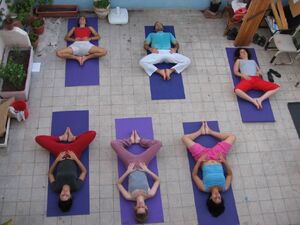Assessment |
Biopsychology |
Comparative |
Cognitive |
Developmental |
Language |
Individual differences |
Personality |
Philosophy |
Social |
Methods |
Statistics |
Clinical |
Educational |
Industrial |
Professional items |
World psychology |
Clinical: Approaches · Group therapy · Techniques · Types of problem · Areas of specialism · Taxonomies · Therapeutic issues · Modes of delivery · Model translation project · Personal experiences ·

A western style hatha yoga class. Some 16m people in the US alone practice this form of yoga.
While Yoga evolved as a spiritual practice, in the West it has grown popular as a form of purely physical exercise. Some Western practice has little or nothing to do with Hinduism or spirituality, but is simply a way of keeping healthy and fit. This differs from the traditional Eastern view of yoga. While it is not always possible (or even desirable) to completely separate "exercise yoga" from "spiritual yoga," this article seeks to concentrate on the former.
Yoga as exercise has evolved into numerous subdivisions and variations. There is some debate whether the term Hatha Yoga properly describes yoga as exercise, since the traditional Hatha Yoga system is a spiritual path in its own right.
Physical benefits of yoga[]
Yoga as exercise for treating diseases[]
Most yoga classes in the U.S. consist of a combination of physical exercises, breathing exercises, and meditation. These characteristics make yoga a particularly beneficial kind of exercise for people with certain health conditions, including heart disease/hypertension, asthma, and back problems.
For people with heart problems, studies have shown yoga to help people young and old. Specifically, yoga seems to promote heart health in several ways, including lowering high blood pressure and improving resistance to psychological stress.[1]
For people with back problems, studies have shown yoga helps physically with strength, flexibility and endurance. Yoga also helps create relaxation through the breathing and meditation techniques employed, which has been shown to help people better proactively manage a chronic pain problem like back pain.[2]
Psychological benefits of yoga[]
See also[]
- Yoga
- Ashtanga Yoga
- Iyengar Yoga
- Raja Yoga
- Naked Yoga
- Yoga (alternative medicine)
- Five Tibetan Rites
- Chair Yoga
- Cardiac yoga
References[]
- ↑ December 2002. Yoga: What is yoga good for? Univ. of Maryland Medical website. Retrieved 11/30/06.
- ↑ December 2003. Yoga for back problems Spine Health Medical website. Retrieved 11/30/06.
| Yogas: | Agni Yoga - Anahata Yoga - Anusara Yoga - Ashtanga Vinyasa Yoga - Bikram Yoga - Hatha yoga - Integral yoga - Iyengar Yoga - Kriya yoga - Kundalini yoga - Natya Yoga - Sahaj Marg - Sahaja Yoga - Satyananda Yoga - Sivananda Yoga - Six yogas of Naropa (Tummo) - Surat Shabd Yoga - Viniyoga - Yoga in Daily Life - Yoga Nidra |
| Texts: | Bhagavad Gita - Yoga Sutras - Hatha Yoga Pradipika - Gheranda Samhita - Shiva Samhita |
| Hinduism paths: | Bhakti yoga - Karma Yoga - Jnana Yoga - Raja Yoga |
| Raja Yoga limbs: | Yama - Niyama - Asana - Pranayama - Pratyahara - Dharana - Dhyana - Samadhi |
| Lists: | Yoga schools and their gurus - Hatha yoga postures |
| Related topics: | Ayurveda - Chakra - Mantra - Tantra - Vedanta - Yoga (alternative medicine) - Yoga as exercise |